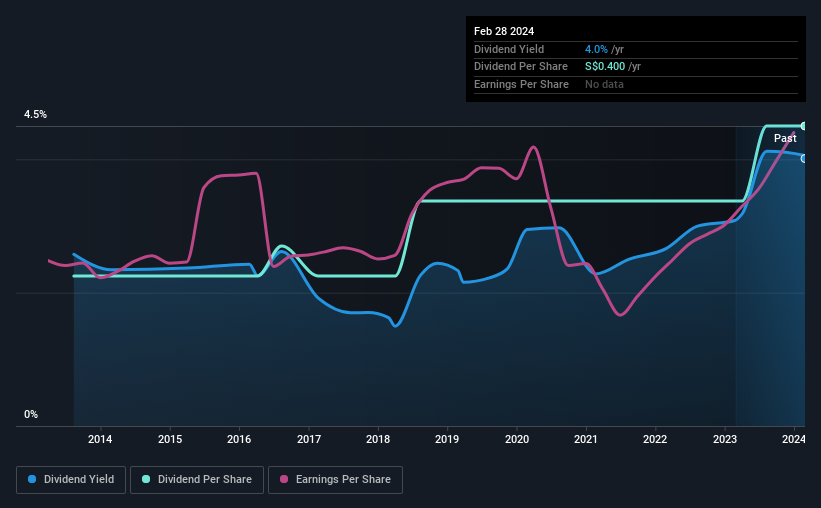Haw Par (SGX:H02) Will Pay A Dividend Of SGD0.20
Haw Par Corporation Limited (SGX:H02) has announced that it will pay a dividend of SGD0.20 per share on the 21st of May. This makes the dividend yield 4.0%, which is above the industry average.
Check out our latest analysis for Haw Par
Haw Par's Dividend Is Well Covered By Earnings
Impressive dividend yields are good, but this doesn't matter much if the payments can't be sustained. The last payment was quite easily covered by earnings, but it made up 161% of cash flows. The company might be more focused on returning cash to shareholders, but paying out this much of its cash flow could expose the dividend to being cut in the future.
If the trend of the last few years continues, EPS will grow by 3.8% over the next 12 months. If the dividend continues on this path, the payout ratio could be 42% by next year, which we think can be pretty sustainable going forward.
Dividend Volatility
The company's dividend history has been marked by instability, with at least one cut in the last 10 years. Since 2014, the annual payment back then was SGD0.20, compared to the most recent full-year payment of SGD0.40. This means that it has been growing its distributions at 7.2% per annum over that time. We have seen cuts in the past, so while the growth looks promising we would be a little bit cautious about its track record.
The Dividend's Growth Prospects Are Limited
With a relatively unstable dividend, it's even more important to evaluate if earnings per share is growing, which could point to a growing dividend in the future. However, Haw Par has only grown its earnings per share at 3.8% per annum over the past five years. The company has been growing at a pretty soft 3.8% per annum, and is paying out quite a lot of its earnings to shareholders. This isn't necessarily bad, but we wouldn't expect rapid dividend growth in the future.
In Summary
In summary, while it's always good to see the dividend being raised, we don't think Haw Par's payments are rock solid. With cash flows lacking, it is difficult to see how the company can sustain a dividend payment. Overall, we don't think this company has the makings of a good income stock.
Market movements attest to how highly valued a consistent dividend policy is compared to one which is more unpredictable. At the same time, there are other factors our readers should be conscious of before pouring capital into a stock. For example, we've identified 2 warning signs for Haw Par (1 is potentially serious!) that you should be aware of before investing. If you are a dividend investor, you might also want to look at our curated list of high yield dividend stocks.
Have feedback on this article? Concerned about the content? Get in touch with us directly. Alternatively, email editorial-team (at) simplywallst.com.
This article by Simply Wall St is general in nature. We provide commentary based on historical data and analyst forecasts only using an unbiased methodology and our articles are not intended to be financial advice. It does not constitute a recommendation to buy or sell any stock, and does not take account of your objectives, or your financial situation. We aim to bring you long-term focused analysis driven by fundamental data. Note that our analysis may not factor in the latest price-sensitive company announcements or qualitative material. Simply Wall St has no position in any stocks mentioned.

 Yahoo Finance
Yahoo Finance 
